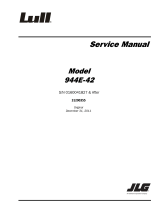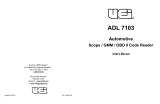Page is loading ...

R
Page 1
TG116
N1301 Alternator
Troubleshooting Guide
C.E. Niehoff & Co.
Contents
Section A: Description and Operation ................................. 2
Section B: Basic Troubleshooting ........................................ 4
Section C: Advanced Troubleshooting ................................ 5
Battery Charging Conditions
The following conditions may be observed during cold-start
voltage tests until temperatures of electrical system compo-
nents stabilize. The time it takes to reach optimum voltage
and amps will vary with engine speed, load, and ambient
temperature.
Maintenance/Low Maintenance Lead-Acid Battery:
Traditional lead acid batteries require lowest charge voltage
of all vehicle battery chemistries. Battery cells must be
maintained by periodically topping off with distilled water as
required.
Maintenance-free Lead-Acid Battery:
Maintenance-free batteries are similar to Maintenance/Low
Maintenance batteries, but may require slightly higher
charge voltage.
Deep-cycle/Marine Maintenance-free Battery:
Charge acceptance of these batteries may display charac-
teristics similar to maintenance-free batteries and may
charge faster due to generally lower capacity relative to
size.
AGM (Absorbed Glass Mat) Maintenance-free Battery:
These dry-cell batteries respond better than standard main-
tenance-free batteries. If battery state of charge (SOC)
drops to 75% or less, batteries should be recharged to 95%
or higher separately from engine charging system to avoid
damaging charging system components and to provide best
overall performance. Charge acceptance of these batteries
may display
characteristics similar to maintenance batteries,
but may require higher charge voltage and will draw signicant
current (<100 amps) when under 50% SOC.
Lithium Battery:
Lithium batteries have unique charging characteristics that
differ from lead acid. These batteries require charging sys-
tems congured specically for lithium battery chemistries.
Contact CEN for more information on lithium battery charg-
ing systems and components.
Testing Guidelines
Professional service technicians rely on the following guide-
lines when testing electrical components.
Voltage testing:
Set meter to proper scale and type (AC or DC).
Be sure to zero the meter scale or identify the meter burden
by touching meter leads together. Meter burden must be
subtracted from nal reading obtained.
Be sure the meter leads touch source area only.
Prevent short circuit damage to test leads or source by
not allowing meter leads to touch other pins or exposed
wires in test area.
Be sure to use CEN tools designed especially for trouble-
shooting CEN alternators when available.
Resistance (ohm) testing:
Set meter to proper scale.
Be sure to zero the meter scale or identify the meter burden
by touching meter leads together. Meter burden must be
subtracted from nal reading obtained.
Be sure meter leads touch source area only. Allowing n-
gers or body parts to touch meter leads or source during
reading may alter reading.
Be sure reading is taken when source is at 70ºF. Readings
taken at higher temperatures will increase the reading.
Conversely, readings taken at lower temperatures will
decrease the reading.
Be sure to test directly at the source. Testing through ex-
tended harnesses or cable extensions may increase the
reading.
"OL" as referenced in this document refers to open circuit:
"innite" resistance, typically in very high kilo- or
megaohm range depending on meter and settings.
Diode testing:
Diodes allow current to ow in one direction only. Typical
voltage drop in forward bias can range from 0.1-0.85V.
Meter should read OL in reverse bias. Check meter user
manual for meter-specic testing guidelines.
Voltage drop testing:
Measure voltage between B+ on alternator or power source
and B- (ground) on alternator or source. Record reading.
Move to batteries or other power source and measure
again between B+ and B- terminals on battery or other
power source. The difference between the two readings
represents voltage lost within circuit due to, but not lim-
ited to, inadequate cable gauge or faulty connections.
Voltage drop measurements must be taken with all electrical
loads or source operating.
Dynamic/Live testing (Connecting power and ground to
component to test operation/function out of circuit):
Connect jumper leads directly and securely to power source
contacts of component being tested.
Make any connection to power and ground at power supply
or battery source terminals. Do not make connection at
component source terminals, as that may create an arc
and damage component source terminals.

R
Page 2 TG116
Section A: Description and Operation
N1301 Alternator
Description and Operation
The N1301 alternator is a hinge mount, negative ground
alternator rated at 28V, 220A. It is self-rectifying and brush-
less; all windings and current carrying components are sta-
tionary, so there are no brushes or slip rings to wear out.
Output voltage can be adjusted to compensate for climate
conditions. N1301 alternators are salt water resistant and
suitabe for marine applications.
.
Figure 2: N1301 Alternator Wiring Diagram
Figure 1: N1301 Alternator Connections
A = B+
B = Energize
C = F-
Output Harness Receptacle
A = F–
B = Energize
C = B-/Ground
D = B+
Regulator Harness
Receptacle
Voltage Selection Control
B-Terminal
N3001 Regulator

R
Page 3
TG116
Section A: Description and Operation (cont.)
SWITCH POSITION VOLTAGE SETPOINT
Factory Setting
(25° C – 45° C)
27.7 V
TROPIC (>45° C) 27.0 V
ARCTIC (< 25° C) 29.1 V
Figure 3: Voltage Setpoint Selection Control
Voltage Setpoint Selection
Charging voltage can be adjusted to compensate for climate
conditions as follows:
1. Twist voltage selection control adapter on alternator
counterclockwise and remove from receptacle. See Fig-
ure 1 on page 2 for adapter location.
2. Re-install adapter so line on face of adapter points to-
ward desired voltage printed on label above receptacle.
Make sure adapter is locked in place. See Figure 3.
Voltage Regulator
Description and Operation
The N3001 voltage regulator is a at temperature compen-
sating regulator that mounts directly on the alternator
housing. The regulator adjusts charge voltage as neces-
sary to maintain setpoint voltage, determined by setpoint
voltage adapter on alternator. Factory setting is 27.7 V.
Regulator is activated when it receives an ignition/energize
signal from the vehicle, usually via oil pressure switch or
multiplex system.
.
Connector Pin Functions
A = F–
B = Energize
C = B–
D = B+
Figure 4: N3001 Voltage Regulator

R
Page 4 TG116
Basic Troubleshooting
1. Inspect charging system components for damage.
Check connections at B– cable, B+ cable, and regula-
tor harness. Check regulator terminal wiring from regu-
lator to vehicle components. Repair or replace any
damaged component before electrical troubleshooting.
2. Inspect vehicle battery connections. Connections must
be clean and tight.
3. Check drive belt. Repair or replace belt as necessary.
4. Determine battery voltage and state of charge. If bat-
teries are discharged, recharge or replace batteries.
Electrical system cannot be properly tested unless bat-
teries are charged 95% or higher.
5. Connect meters to alternator:
a. Connect DMM red lead to alternator B+ terminal
on alternator output harness receptacle. Refer to
Figure 1 on page 2 for terminal location.
b. Connect DMM black lead to alternator B– termi-
nal. Refer to Figure 1 on page 2 for termnal loca-
tion.
c. Clamp inductive ammeter onto B+ cable.
4. Operate vehicle and observe charge voltage. Charge
voltage should increase and charge amps should de-
crease. Battery is considered fully charged when
charge voltage is at setpoint voltage and charge amps
remain at lowest value for 10 minutes.
a. If voltage is at or below setpoint, allow charging
system to operate for several minutes to normalize
operating temperature.
b. If charge voltage exceeds 32 volts, shut down sys-
tem immediately.
Damage to electrical system may occur
if charging system is allowed to operate
above 32V for more than 3 seconds.
3. If charge voltage does not increase within 10 min-
utes, go to Chart 1 on page 5.
Section B: Basic Troubleshooting
Preliminary Check-out
Check symptoms in Table 2 below and correct if
necessary.
Required Tools and Equipment
Identication Record
Enter the following information in the spaces provided for
identication records.
Alternator model number: _____________________
Regulator model number: _____________________
Voltage setpoints listed on regulator: ____________
TABLE 2: Preliminary Charging System Check-Out
CONDITION: CHECK FOR:
Low voltage output • Loose drive belt.
• Low battery state of charge.
• Load on system exceeds rated
output of alternator.
• Low voltage setpoint.
• Faulty wiring or poor ground
path.
• Faulty alternator or regulator.
• Wrong regulator installed.
High voltage output • High regulator setpoint.
• Faulty regulator.
• Faulty alternator.
No voltage output • Broken drive belt.
• Faulty alternator output terminal
connection.
• Faulty alternator or regulator.
Failure to check for the conditions
listed in Table 2 below will result
in erroneous test results in the
troubleshooting charts.
• Digital Multimeter (DMM)
• Ammeter (digital, inductive)
• Jumper wires
Set DMM to Diode Test . Connect DMM black lead to
pin E (Phase) on harness plug. Connect DMM red lead to
B‒ terminal on alternator. Does DMM read OL?
Reverse DMM leads. Does DMM read ow?
CAUTION
NOTICE

R
Page 5
TG116
MASTER BATTERY SWITCH ON, KEY ON, ENGINE ON: Test for battery voltage from harness pin A to ground and from pin
B to ground. Does battery voltage exist at both locations?
Yes
No
Set DMM to Diode Test . Connect DMM black lead to
pin E (Phase) on harness plug. Connect DMM red lead to
B‒ terminal on alternator. Does DMM read OL?
Reverse DMM leads. Does DMM read ow?
Section C: Advanced Troubleshooting
Chart 1: No Alternator Output – Test Charging Circuit
• TEST MEASUREMENTS ARE TAKEN FROM CONNECTORS AT ALTERNATOR. TAKING MEASUREMENTS FROM AN
EXTENDED HARNESS PLUG MAY AFFECT RESULTS.
• FOR REMOTE-MOUNTED REGULATOR, CHECK CONDITION OF HARNESS/ FUSES BEFORE TROUBLESHOOTING.
• BEFORE STARTING DIAGNOSTIC SEQUENCE, VERIFY THE FOLLOWING AND REPAIR/REPLACE IF NOT TO SPEC:
−BATTERIES FOR STATE-OF-CHARGE (25.0-28.0 V), CONDITION, AND SECURE CONNECTIONS.
−MASTER BATTERY SWITCH FOR FUNCTION.
CAUTION
MAKE SURE METER PROBES DO NOT TOUCH OTHER PINS/SOCKETS AND CAUSE AN ARC THAT MAY
DAMAGE PINS/SOCKETS AND HARNESS WIRING.
A = F–
B = Energize
C = B-/Ground
D = B+
A = B+
B = Energize
C = F-
Figure 5: Regulator Harness Receptacle Pins Figure 6: Output Harness Receptacle Pins
System is operative.
Repair vehicle wiring as necessary. Run engine and re-test
charging circuit. Is charging system performing properly?
No
Yes
Turn engine off. Disconnect regulator harness.
Carefully test directly from regulator harness
receptacle.
1. B+ sense test: Set DMM to Ohms. Connect DMM black lead to pin D in regulator receptacle and connecto DMM red lead
to pin A of output receptacle. DMM should read <1 Ω.
2. Field coil resistance test: Set DMM to Ohms. Connect DMM black lead to pin A in regulator harness receptacle. Connect
DMM red lead to pin D. Resistance should measure 1.0-1.5 ± 0.2 Ω. (Field coil is faulty if reading is < 0.5 Ω or >3 Ω).
3. Field coil isolation test: Set DMM to Ohms. Measure resistance between pin A in regulator harness receptacle and alterna-
tor B- terminal. DMM should read OL.
4. Regulator circuit energize test. Set DMM to Ohms and disconnect output harness. Connect DMM black lead to pin B in
regulator harness receptacle. Connect DMM red lead to pin B in output harness receptacle. Resistance should measure
45 ± 5 Ω.
Did all tests produce correct readings?
Yes
Regulator is faulty. Alternator is faulty.
No
MASTER BATTERY SWITCH ON, KEY OFF, ENGINE OFF, VOLTAGE SELECT PLUG IN "TROPIC" POSITION.
Readings of all four tests must pass.
MASTER BATTERY SWITCH ON, KEY ON, ENGINE OFF: Disconnect vehicle output harness from alternator.

R
Page 6 TG116
If you have questions about your alternator or any of these test procedures, or if you need to locate a Factory Authorized Service Distributor, please contact us at:
C. E. Niehoff & Co.• 2021 Lee Street • Evanston, IL 60202 USA
TEL: 800.643.4633 USA and Canada • TEL: 847.866.6030 outside USA and Canada • FAX: 847.492.1242
E-mail us at service@CENiehoff.com
/


